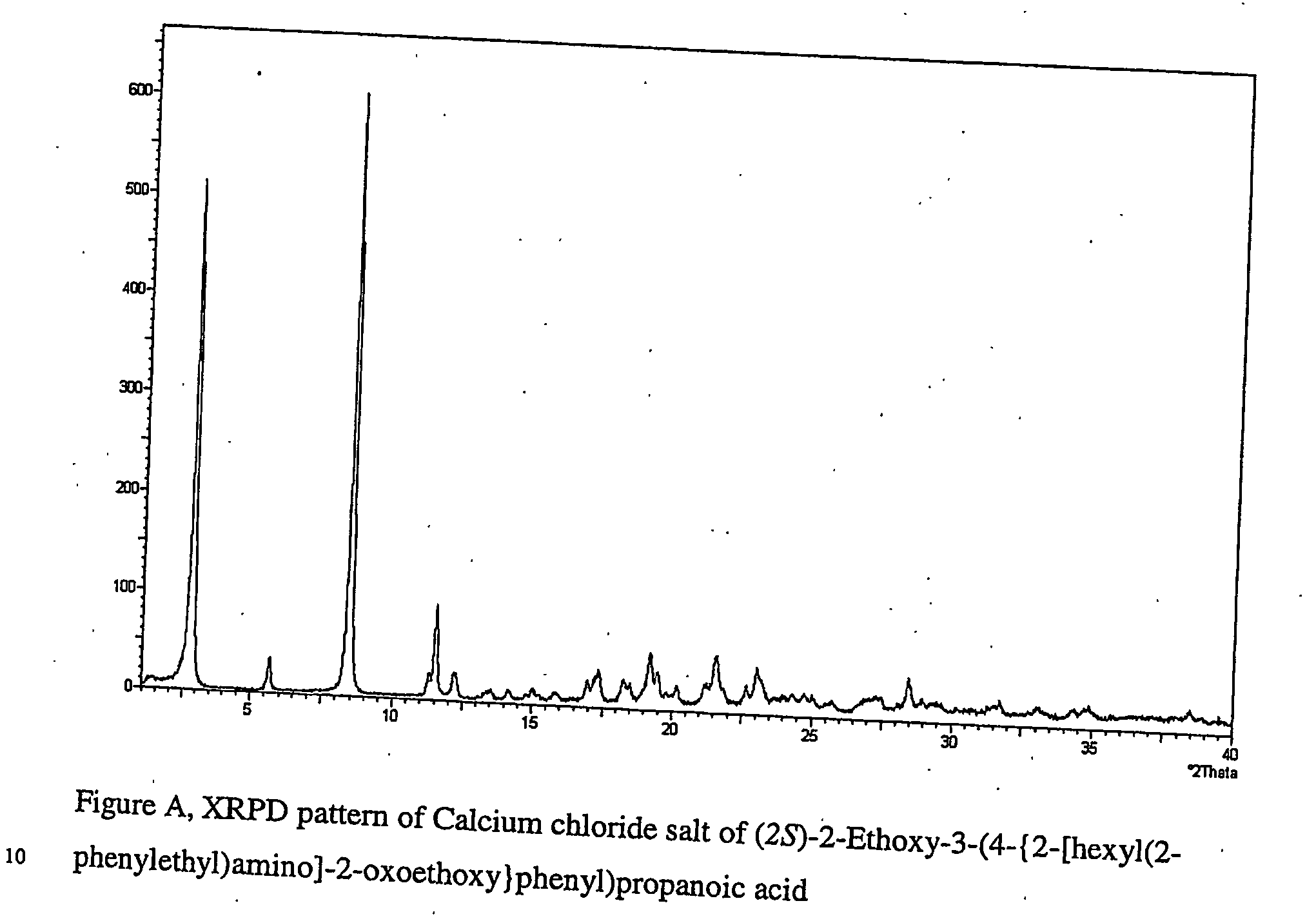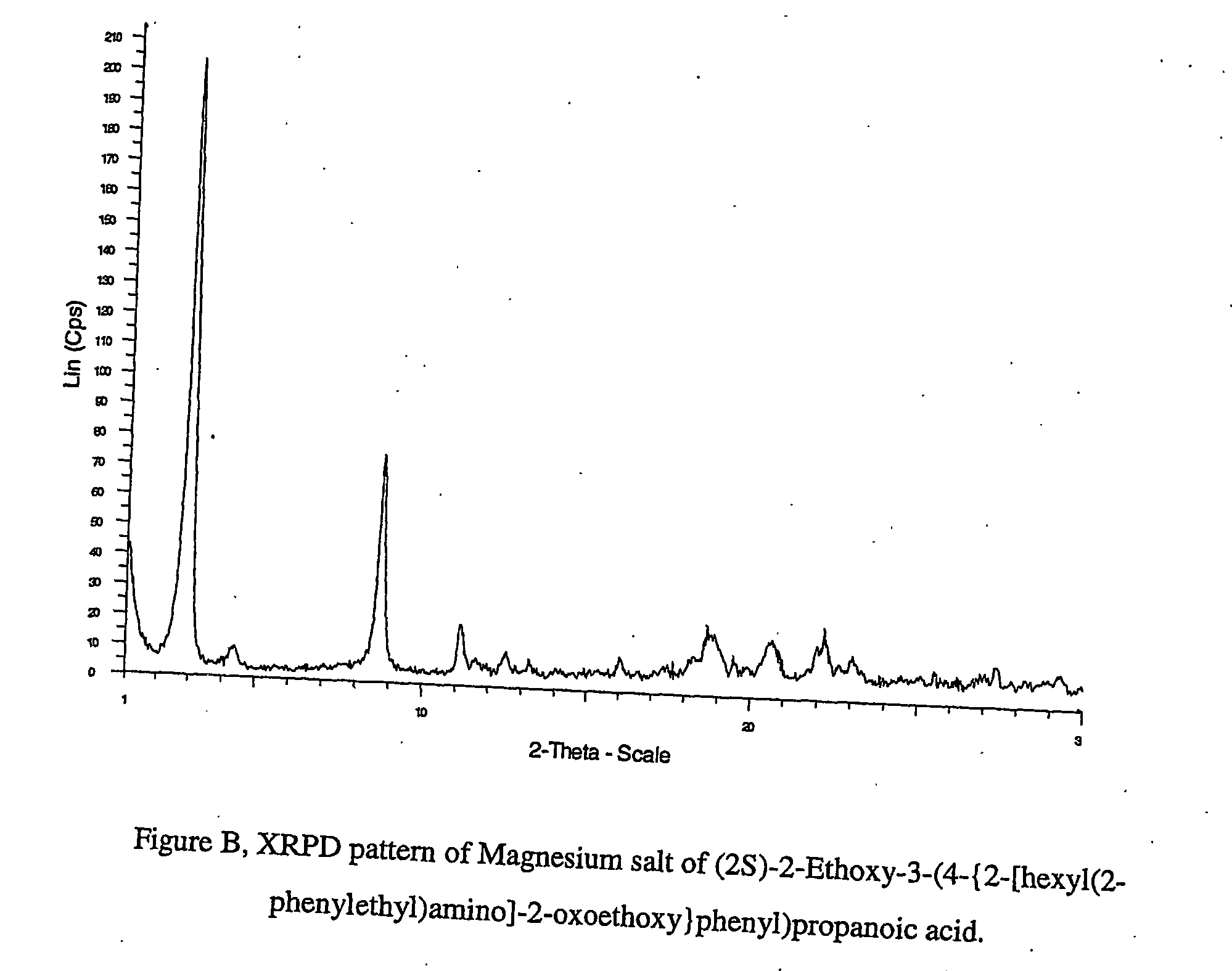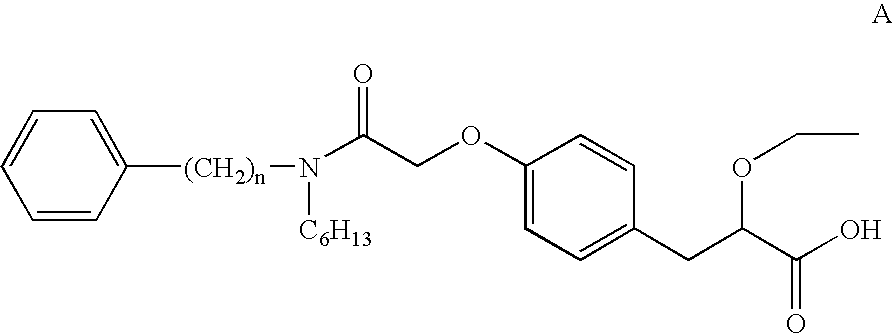Pharmaceutically useful salts of carboxylic acid derivates
a technology of carboxylic acid and salts, which is applied in the direction of drug compositions, peptide/protein ingredients, metabolic disorders, etc., can solve the problems of not being able to provide information in relation to the risk of cardiovascular morbidity and mortality, not being universally accepted as a diagnosis, and being unable to provide universal information
- Summary
- Abstract
- Description
- Claims
- Application Information
AI Technical Summary
Benefits of technology
Problems solved by technology
Method used
Image
Examples
example 1
[0148] (2S)-2-Ethoxy-3-(4-{2-[hexyl(2-phenylethyl)amino]-2-oxoethoxy}phenyl)propanoic acid (0.52 g) was dissolved in isopropanol (23 ml / g), NaOH (0.94 mole equiv) was added together with water (0.5 ml / g) followed by addition of CaCl2 (0.95 mole equiv). The solution was stirred at 40° C., and NaCl was formed. The NaCl was then filtered off and the excess of water in the filtrate was evaporated off using the azeotrope between IPA and water. The solution was concentrated to 5 ml / g and then antisolvent, a mixture of isopropyl acetate and isooctane 50 / 50 (23 ml / g), was added. The product (0.48 g) was collected by filtration.
[0149]1H-NMR (400 MHz, DMSO-d-6): 7.4-7.1 (6H, m), 7.05 (1H, d), 6.7 (1H, d), 6.5 (1H, d), 4.7 (1H, s), 4.3 (1H, s), 3.65 (1H, m), 3.55-3.35 (3H, m), 3.25 (1H, t), 3.15 (2H, m), 2.85 (2H, m), 2.75 (1H, t), 2.6 (1H, m), 1.45 (2H, br s), 1.2 6H, br s), 0.95 (3H, m), 0.8 (3H, m).
example 2
[0150] (2S)-2-Ethoxy-3-(4-{2-[hexyl(2-phenylethyl)amino]-2-oxoethoxy}phenyl)propanoic acid (5.27 g) was dissolved in isopropyl acetate (10 ml / g), then NaOH (2.3 mole equiv) was added followed by addition of water (5 ml / g) and addition of CaCl2 (1 mole equiv). The solution was stirred in room temperature and the water phase was discarded. The organic phase was evaporated with IPA (10 ml / g), then one more portion of CaCl2 dissolved in water (0.5 ml / g) was added at increased temperature (50° C.), and antisolvent, diisopropylether (10 ml / g) was added. The slurry was cooled to 0° C., and the product (3.48 g) was filtered off and identified as calcium chloride (2S)-2-ethoxy-3-(4-{2-[hexyl(2-phenylethyl)amino)]2-oxoethoxy}phenyl)propanoate dihydrate
[0151]1H-NMR (400 MHz, DMSO-D6): 7.4-7.0 (7H, m), 6.7 (1H, d), 6.6 (1H, d), 4.7 (1H, s), 4.5 (1H, s), 3.7 (1H, m), 3.5 (2H, m), 3.3 (2H, t), 3.2 (2H, m), 2.9 (2H, m), 2.7 (2H, m), 1.5 (2H, br m), 1.2 (6H, br s), 1.0 (3H, t), 0.9 (3H, m)
Magnesi...
example 3
[0152] (2S)-2-Ethoxy-3-(4-{2-[hexyl(2-phenylethyl)amino]-2-oxoethoxy}phenyl)propanoic acid was dissolved in 95% ethanol, followed by addition of Mg(OAc)2.4H2O (1 mole equiv). The solution was stirred at room temperature, followed by evaporation to dryness and addition of isooctane (10 ml / g). The slurry was stirred at room temperature, the product was collected by filtration to give a magnesium salt of (2S)-2-ethoxy-3-(4-{2-[hexyl(2-phenylethyl)amino]-2-oxoethoxy}phenyl)propanoate which was analysed by XRPD.
PUM
| Property | Measurement | Unit |
|---|---|---|
| Electrical conductance | aaaaa | aaaaa |
| Electrical resistance | aaaaa | aaaaa |
Abstract
Description
Claims
Application Information
 Login to View More
Login to View More - R&D
- Intellectual Property
- Life Sciences
- Materials
- Tech Scout
- Unparalleled Data Quality
- Higher Quality Content
- 60% Fewer Hallucinations
Browse by: Latest US Patents, China's latest patents, Technical Efficacy Thesaurus, Application Domain, Technology Topic, Popular Technical Reports.
© 2025 PatSnap. All rights reserved.Legal|Privacy policy|Modern Slavery Act Transparency Statement|Sitemap|About US| Contact US: help@patsnap.com



